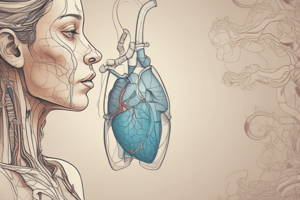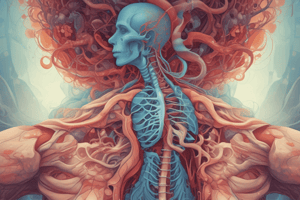Podcast
Questions and Answers
What is the primary mechanism by which oxygen and carbon dioxide travel in and out of cells?
What is the primary mechanism by which oxygen and carbon dioxide travel in and out of cells?
- Active transport
- Diffusion (correct)
- Facilitated diffusion
- Osmosis
Which adaptation primarily increases the efficiency of gas exchange in respiratory organs?
Which adaptation primarily increases the efficiency of gas exchange in respiratory organs?
- Large surface area (correct)
- Thin muscular walls
- Thick epithelial layers
- High blood pressure
What is the role of a circulatory system in respiration?
What is the role of a circulatory system in respiration?
- To create a pressure difference for diffusion
- To absorb oxygen through skin
- To filter carbon dioxide from blood
- To transport oxygen-rich blood to tissues (correct)
In amphibians, what facilitates oxygen uptake primarily during their larval stage?
In amphibians, what facilitates oxygen uptake primarily during their larval stage?
What is the primary significance of minimal distance for diffusion in respiratory surfaces?
What is the primary significance of minimal distance for diffusion in respiratory surfaces?
What distinguishes external gills from internal gills?
What distinguishes external gills from internal gills?
Which type of respiration is NOT associated with gills?
Which type of respiration is NOT associated with gills?
How does the anatomical structure of the alveoli support gas exchange?
How does the anatomical structure of the alveoli support gas exchange?
What characterizes the gills of Agnathans?
What characterizes the gills of Agnathans?
Which process is used by parasitic lampreys for ventilation?
Which process is used by parasitic lampreys for ventilation?
What is the role of the interbranchial septum in Elasmobranch gills?
What is the role of the interbranchial septum in Elasmobranch gills?
Which component is not part of the gill structure in Teleost fish?
Which component is not part of the gill structure in Teleost fish?
What distinguishes a holobranch from a hemibranch?
What distinguishes a holobranch from a hemibranch?
How do Elasmobranchs control the movement of water across their gills?
How do Elasmobranchs control the movement of water across their gills?
What is the primary function of the secondary lamellae on gills?
What is the primary function of the secondary lamellae on gills?
What happens to the gills of amphibians during metamorphosis?
What happens to the gills of amphibians during metamorphosis?
What is the primary advantage of countercurrent exchange in fish gills compared to concurrent exchange?
What is the primary advantage of countercurrent exchange in fish gills compared to concurrent exchange?
During the suction phase of the gill ventilation mechanism, which cavity is under low pressure?
During the suction phase of the gill ventilation mechanism, which cavity is under low pressure?
Which of the following structures in fish is primarily responsible for the gas exchange process?
Which of the following structures in fish is primarily responsible for the gas exchange process?
What is the role of the countercurrent mechanism in fish gills?
What is the role of the countercurrent mechanism in fish gills?
How does water flow during the force phase of the dual-pump mechanism?
How does water flow during the force phase of the dual-pump mechanism?
Which statement best describes the efficiency of oxygen transfer in fish gills?
Which statement best describes the efficiency of oxygen transfer in fish gills?
In the context of fish respiration, what does the term 'dual-pump mechanism' refer to?
In the context of fish respiration, what does the term 'dual-pump mechanism' refer to?
What happens to the pressure in the buccal and opercular cavities during the suction phase?
What happens to the pressure in the buccal and opercular cavities during the suction phase?
Flashcards
Diffusion
Diffusion
The movement of molecules from an area of high concentration to an area of low concentration.
Respiration
Respiration
The process of taking in oxygen and releasing carbon dioxide.
Gills
Gills
Specialized organs in aquatic animals that extract oxygen from water.
Gill lamellae
Gill lamellae
Signup and view all the flashcards
Operculum
Operculum
Signup and view all the flashcards
Internal Gills
Internal Gills
Signup and view all the flashcards
External Gills
External Gills
Signup and view all the flashcards
Metamorphosis
Metamorphosis
Signup and view all the flashcards
One-way Flow Ventilation
One-way Flow Ventilation
Signup and view all the flashcards
Tidal Ventilation
Tidal Ventilation
Signup and view all the flashcards
Branchial Arch
Branchial Arch
Signup and view all the flashcards
Primary Lamellae
Primary Lamellae
Signup and view all the flashcards
Secondary Lamellae
Secondary Lamellae
Signup and view all the flashcards
Adductor Muscles
Adductor Muscles
Signup and view all the flashcards
Buccal Cavity
Buccal Cavity
Signup and view all the flashcards
Countercurrent exchange
Countercurrent exchange
Signup and view all the flashcards
Afferent blood
Afferent blood
Signup and view all the flashcards
Efferent blood
Efferent blood
Signup and view all the flashcards
Suction phase
Suction phase
Signup and view all the flashcards
Force phase
Force phase
Signup and view all the flashcards
Study Notes
Respiratory System
- Oxygen and carbon dioxide travel in and out of cells via passive transport (diffusion)
- Diffusion doesn't occur effectively over large distances (>1mm) thus respiratory and circulatory systems are needed to maintain O2 and CO2 partial pressures
- Key factors for diffusion include large surface area, minimal distance for diffusion, tissue permeability, and fluid circulation (inside/outside body)
- Fish and tetrapods both breathe a respiratory medium (water or air) to extract oxygen and distribute it to body tissues for cellular respiration
- Respiratory organs like gills or lungs have specialized surfaces (e.g., secondary gill lamellae, alveoli) for gas exchange through simple diffusion
- Adaptations that aid diffusion include a large surface area (e.g., secondary gill lamellae, alveoli) and minimal diffusion distance (simple epithelium) and tissue permeability.
- Fluid circulation enables continuous delivery of oxygen-rich blood to tissues.
Organs of Respiration (Gills)
- Oxygen dissolves in water, extracted using gills
- Internal gills are located inside the body, lining the pharyngeal slits, protected by operculum (bony fish) or interbranchial septum (cartilaginous fish).
- External gills hang outside the body (e.g., amphibian larvae)
- Gills have dense capillary beds for gas exchange, located in the capillaries, not in arteries, arterioles, veins, or venules
- Gills are respiratory organs for fish breathing water, lungs are respiratory organs for tetrapods breathing air
Additional Gill Details
-
Agnathans have simple gill frills lining the interior of branchial pouches; in parasitic lampreys water flows in and out of pharyngeal slits (tidal ventilation)
-
Elasmobranchs have more complex gill support structures
-
Agnathans (e.g., lampreys) have no outer covering protecting the gill chamber
-
In free-living lampreys water flows one-way through mouth and out gill slits and across gill surfaces for oxygen extraction
-
In parasitic lampreys, mouth blocked, water flows in and out through gill slits = tidal ventilation (unlike most fish)
-
Branchial muscles pump water in and out in fish gill ventilation
-
Elasmobranchs (e.g., sharks) have soft skin forming a "flap valve" extending to gill rays for support inside the interbranchial septum
-
Hemibranch only has gill lamellae on one side of a gill arch
-
Holobranch has lamellae on both sides of a gill arch
Teleost Fish Gill Structures
- Teleost fish have more complex V-shaped gills with primary and secondary lamellae
- Adductor muscles control the amount of space between gills
- Water movement in teleost fish is via dual-pump mechanism (buccal cavity and opercular cavity); these expand or contract to create low or high pressure, respectively
Countercurrent Gas Exchange
- Countercurrent gas exchange in virtually all fish gills is much more efficient than concurrent exchange in transferring oxygen
- Blood and water flow in opposite directions to maintain a steep concentration gradient of oxygen
- This constant gradient is vital for a very efficient exchange of O2 from water into the blood
Ventilation Mechanisms
- Fish gill ventilation can be through a dual pump mechanism involving buccal and opercular cavities.
- Valves in elasmobranch gills, parabranchial ventilation in some species, are crucial for one-way controlled gill flow
- Some large fish also employ ram ventilation to obtain the flow of water needed for oxygen transfer as they swim, during this type of ventilation, forward movement is crucial to allow water to flow past the gills
Studying That Suits You
Use AI to generate personalized quizzes and flashcards to suit your learning preferences.




